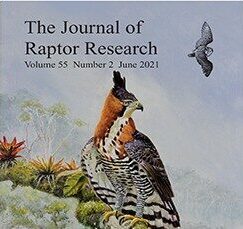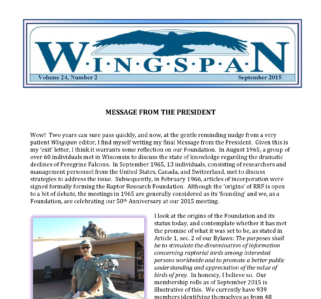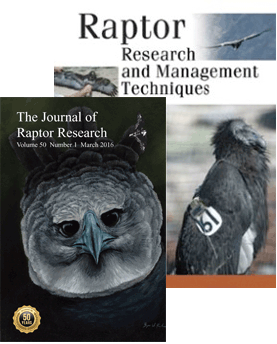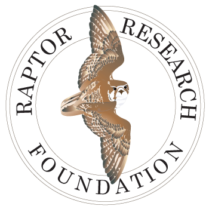History
BEGINNING OF RRF
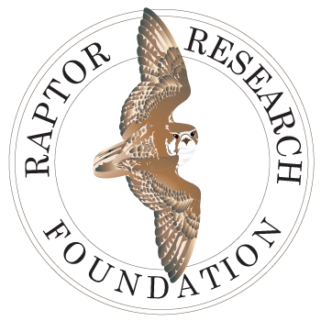
The very first meeting of the RRF occurred in Madison, Wisconsin, USA in September 1965 following a major conference on the status of Peregrine Falcon populations held there the year before. A group of 13 concerned people met to decide what to do about the apparently declining peregrine populations.
Chairman: Don Hunter, South Dakota , USA
David Hancock, B.C., Canada
Lucille F. Stickel, Maryland, USA
Frank Beebe, B.C., Canada
W. H. Stickel, Maryland, USA
Richard Fyfe, N.B., Canada
Morlan Nelson, Idaho, USA
Joe Simonyi, Ontario, Canada
Steve Herman, California, USA
Fran Hamerstrom, Wisconsin, USA
Grainger Hunt, Texas, USA
Frederick Hamerstrom, Wisconsin, USA
Hans Herren, Switzerland
Among those in attendance was Don Hunter, a lawyer and falconer from South Dakota. When Don returned to South Dakota, he contacted Byron Harrell at the University of South Dakota and Paul Springer with the U.S. Fish and Wildlife Service. These three signed the articles of incorporation on 11 February 1966, officially starting the Raptor Research Foundation with the stated purpose “to stimulate the dissemination of information concerning raptorial birds among interested persons world wide and to promote a better public understanding and appreciation of the value of birds of prey.”
The first officers were Byron Harrell, President, Paul Springer, Vice-President, and Don Hunter, Treasurer. Later that year George Jonkel became the first Secretary. The founders were somewhat concerned about calling the organization a foundation because foundations generally have money in support of a mission, whereas the RRF had a mission but no money.
The founders’ idea was to create a clearinghouse to assemble and coordinate information on raptor ecology and captive breeding.
Their initial thrust was to investigate the status of the peregrine falcon and learn how to breed the species in captivity. Two conferences were subsequently held in Sioux Falls, South Dakota on November 22-23, 1971 and November 24-26, 1972, respectively, for the express purpose of discussing how to breed raptors in captivity with the objective of putting them back into the wild.
After a highly successful meeting on Raptor Conservation Techniques held on March 22-24, 1973 in Fort Collins, Colorado, USA which was well-attended by many of the top raptor biologists in the world concerned by the various threats facing raptor populations, the next pivotal meeting was held in November 1974 in St. Paul, Minnesota, USA. There, an interim board of directors was established, consisting of Joe Murphy as President, Tom Cade as Vice-President, Edward Freienmuth as Treasurer, Richard (Butch) Olendorff as Secretary, and directors, Don Hunter, Dean Amadon, Byron Harrell, and Richard Fyfe.
In 1974, the RRF had close to 600 members and about $5,000 in the bank. Few researchers were working on raptors in those days primarily because funds were not widely available for raptor research, but the RRF membership grew unexpectedly quickly. From just over 30 members in 1966, it grew to over 250 in 1967 and to almost 1,000 world-wide today.
Today, the RRF offers six main services to its members: international annual meetings, The Journal of Raptor Research, a quarterly peer-reviewed journal, Wingspan, a biannual online newsletter, several special publications, sources of funds for research and various achievements, and awards honoring the achievements of its members.
CONFERENCES
Regarding annual meetings, their locations have previously alternated from east to mid-continent to west in North America with the first conferences outside the U.S. being held in Montreal and Winnipeg in Canada and Veracruz and La Paz in Mexico. The most notably large U.S. meeting was the hugely successful international RRF meeting organized by Butch Olendorff and hosted in Sacramento, California in 1985. Two of the most popular North American locations have been Allentown, Pennsylvania and Boise, Idaho. On a number of occasions, including the North American Ornithological Conferences held in 2002 and 2006, the RRF has co-organized its meetings with other organizations and institutions, e.g. American Ornithologists’ Union, Wilson Ornithological Society , Cooper’s Ornithological Society, Hawk Migration Association of North America, Hawk Mountain Sanctuary, falconry clubs like the California Hawking Club, several raptor centers, numerous universities, and government departments.
The first overseas meetings were jointly organized with the World Working Group on Birds of Prey in various colorful locations, e.g. Mexico, Spain, and Israel, but the RRF also held its own Eurasian meetings in England, Italy, Czech Republic, and Spain.
The very first annual meeting of the RRF membership outside the confines of North America took place in Pitlochry, Scotland in 2009. Some of these meetings have featured special sessions or piggy-backed conferences on important themes, sometimes focusing on species, e.g. peregrine falcons, California condors, bald eagles, American kestrels, to name but a few, and at other times, on specialized techniques in the realms of veterinary medicine and rehabilitation, captive breeding and reintroduction, and public education. The RRF meetings continue today to attract a wide audience composed of experts in energy development ranging from electricity to wind turbines, conventional and satellite radio telemetry, migration, and ecotoxicology, again to name but a few.
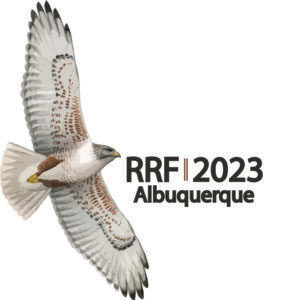
PUBLICATIONS
The Journal of Raptor Research (JRR) has also had an interesting evolution. It was initially published as Raptor Research News with Volume 1 in 1967, a little white booklet garnished with a gyrfalcon on a falconer’s perch as a logo and edited by Byron Harrell and Don Hunter. The very first issues published in Vermillion, South Dakota, USA contained a report on the 1971 conference on the captive breeding of raptors held in Sioux Falls.
But under the editorship of Butch Olendorff, the first edition of Raptor Research, Volume 6, came out in 1972. With a light green cover sporting a new logo still used by the RRF today, i.e. a flying prairie falcon drawn by artist Robert Katona, that issue featured not only reports on captive breeding successes of various raptors of concern, but most importantly, it presented the very first scientific papers on raptor research and biology. Over the coming years, the subject matter of the papers has broadened to cover basic raptor biology, veterinary and telemetry techniques, physiology, population ecology, etc.
Butch Olendorff continued in his role as editor of the journal until 1976 when Clayton White, a peregrine falcon specialist and a professor at Brigham Young University in Provo, Utah, USA racked up an amazing editorial tenure of ten years and established the journal as a bonafide outlet for publishing new information on raptor research. In 1986, Clayton was followed by one of his own graduate students, Jimmie Parrish. Other dedicated editors include Josef Schmutz, Carl Marti, Marc Bechard, James Bednarz and Cheryl Dykstra. The change in the journal’s name to The Journal of Raptor Research in 1989 greatly facilitated its recognition as an important scientific publication.
Today, it is refreshing to see not only a wide variety of subjects, but more importantly, material written by authors from all over the world. With its return to a khaki green cover, each decorated with a different painting of a bird of prey, The Journal of Raptor Research is beyond any doubt the premier periodical for publishing papers on birds of prey in the world today. The original founders of this highly successful journal, most no longer with us, must surely be applauded for their foresight, dedication and hard work. Even the biannual newsletter, Wingspan, has undergone several permutations through various editors to now being an online feature of the RRF. This valuable and timely publication allows the RRF members to be quickly and effectively kept abreast of breaking news in the raptor world, including recent achievements, needs, and upcoming events.
Along with the journal and the newsletter, the RRF has, over the years, been responsible for organizing many important meetings which have led to the publication of invaluable conference proceedings in the form of books and reports.
Some examples include Biology and Management of Bald Eagles and Ospreys, The Ancestral Kestrel, Raptors in Human Landscapes, and The Burrowing Owl: Its Biology and Management. Other special reports have focused on reducing electrocutions from powerlines and raptor habitat management. Perhaps the most influential publication to originate from the RRF is the latest version of its manual, Raptor Research and Management Techniques, which was published jointly with Hancock House Publications in 2007. This highly useful book, which should be on the library shelf of any self-respecting raptor biologist, has now been translated into Japanese and Spanish, with other language translations in the works.
Finally, it must be remembered that the Raptor Research Foundation is just as much about the people who comprise it as the birds we all love. While folks dedicated to the organization come and go, their contributions, however small, should never be forgotten.
Past Presidents
1966 – 1974 Byron Harrell
1975 – 1977 Joe Murphy
1977 – 1981 Richard (Butch) Olendorff
1981 – 1987 Jeffrey Lincer
1988 – 1989 Gary Duke
1990 – 1993 Richard (Dick) Clark
1994 – 1995 Michael Collopy
1996 – 1997 David Bird
1998 – 2001 Michael Kochert
2002 – 2006 Brian Millsap
2007 – 2009 Leonard Young
2009 – 2013 Ruth Tingay
2013 – 2015 Clint Boal
2015 – 2017 Miguel Saggese
2017 – 2021 Elizabeth (Libby) Mojica
